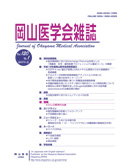

Journal of Okayama Medical Association
Published by Okayama Medical Association<Availability>
Full-text articles are available 3 years after publication.
Permalink : https://ousar.lib.okayama-u.ac.jp/41097
The Influence of the Function of Adrenal Cortex upon the Duration of Intravenous Anesthesia Part 1. Respiratory restraint of intravenous injection
Kawasaki, Toshio
Published Date
1959-08-30
Abstract
The duration of anesthesia was estimated with three intravenous anesthetics, Ravonal, Thioval and Isozol. Using the phenomenon of the expansion and contraction of rubber tube filled with saturated blue vitriol solution which changes by respiratory movement and causes the fluctuation of resistence value of blue vitriol, the depth and frequency of respiration was estimated by pneumograph. By its curve, the beginning and end of respiratory restraint, duration of anesthesia and the decreasing ratio of respiratory volume were studied. 1) The anesthetic duraton is longest by Isozol. In rabbits it is about 1.2 times and in human about 1.3 times longer than by Thiopenthal. Ravonal and Thioval are almost the same. 2) Both in rabbits and in human, the decreasing ratio of respiration is the largest by Ravonal. Thioval follows and the smallest is by. lsozol. 3) The beginning of respiratory restraint is the latest by lsozol in rabbits but there is no significant difference in human. Its end is equal in rabbits but in human it is earliest by Isozol. 4) The duration of respiratory restraint is the shortest by Isozol both in rabbits and in human. 5) Isozol decreases the respiratory frequency markedly but scarcely changes the respiratory amplitude. On the contrary, in case of Thiopenthal, respiratory amplitude decreases and the respiratory frequency decreases slightly in rabbits but shows no variation in human.
ISSN
0030-1558
NCID
AN00032489
